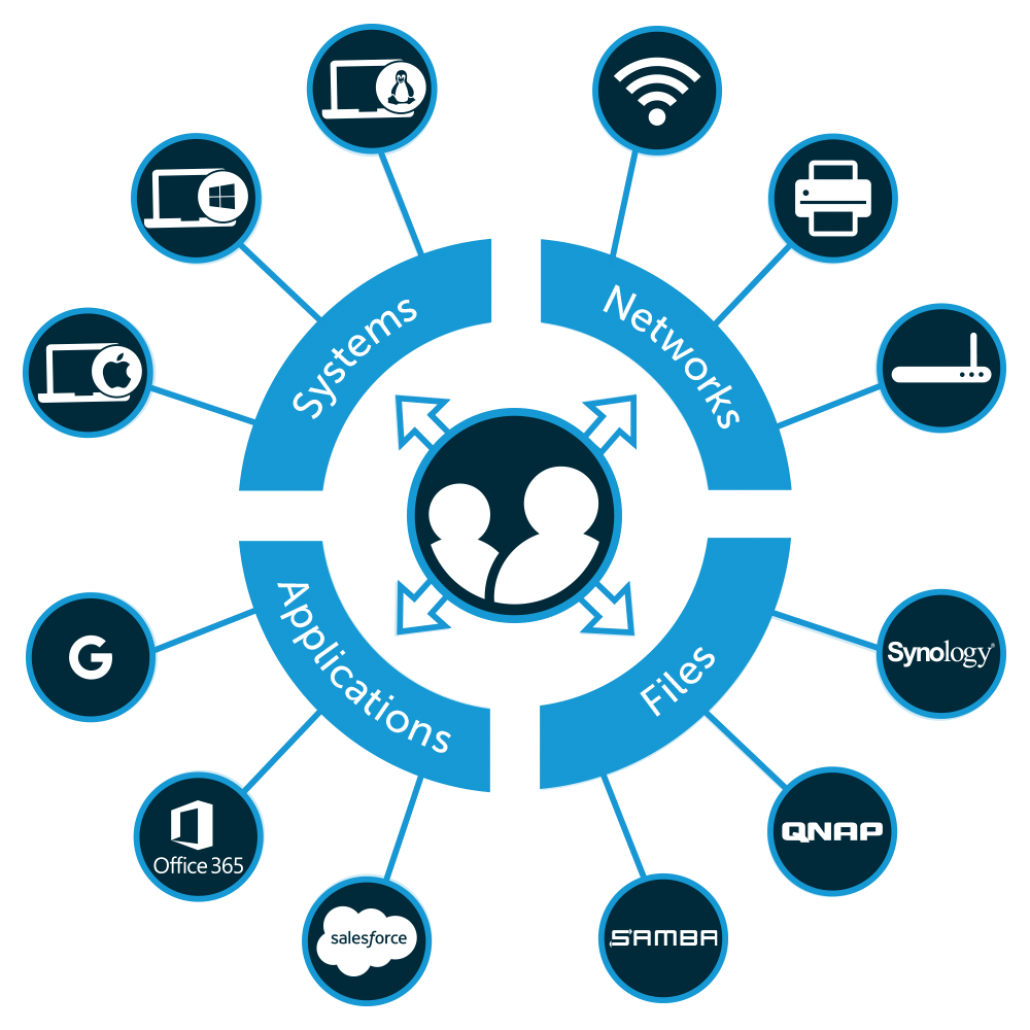CO-based MSP Leverages SaaS Services to Capitalize on Client Demand
Introduction
Based near JumpCloud’s headquarters in Boulder, Colorado, Altitude Integrations is a cloud-focused Managed Service Provider (MSP) that services dozens of client organizations in various industries. Altitude Integrations provides a carefully selected ‘stack’ of integrated solutions to satisfy the needs of their clients and stay ahead of the curve. Much like the companies they manage, Altitude Integrations is outgrowing the taste for on-prem maintenance, and has full intentions of scaling their business using cloud-based solutions. Until fairly recently, however, clients did not always see eye-to-eye concerning cloud-based security and identity management. For their business and their clients’ benefit, Brett Ramberg, Altitude Integration’s CEO and owner, needed to find a comprehensive solution in order to make a successful transition away from the on-prem, break-fix business model to being a reliable, cloud-forward integrator. Read the accompanying case study with Altitude Integration’s Lead Technician, Jan Kalkus, to understand Altitude Integration’s transition from a more technical standpoint.
- Organization: Altitude Integrations
- Size: 11 employees; approx. 125 clients
- Location: HQ in Boulder, CO, USA
- Problem: Altitude Integrations needed to replace Active Directory and transform their business model from break-fix to cloud-forward integrators.
- Goal: Altitude Integrations is determined to revamp their product stack and move all clients to the cloud.

Altitude Integrations Owner & CEO
Background
By design, Altitude Integrations locally and remotely supports client organizations that are growing quickly. In the past, this support included on-prem maintenance for Microsoft-based solutions, and relied on a break-fix business model for generating revenue. However, a shifting IT landscape and increased demand for cloud-based solutions have encouraged Altitude Integrations to reconsider this business model. As their clientele of startup organizations look to scale their operations, they are looking to Altitude Integrations for IT assistance with rapid onboarding, identity security, and full-scale access to cloud-based resources.
“We tend to work with businesses that are scaling pretty quickly. That probably has something to do with the region we’re in, but companies that are scaling quickly tend to see more value in their IT, and those are the types of clients we want,” Ramberg explained. “Companies that are scaling want to triple their size in a year or two. They want to invest now, so when they do get there, it isn’t going to be as hard. They want to make those changes now, invest now, and grow and scale.”
Since these types of companies are relatively young, they present a slightly different scenario from older and larger enterprises. Instead of bringing a laundry list of on-prem infrastructure issues to Altitude Integrations, they’re coming to them for advice on the cloud, and asking how they can avoid well-known growing pains down the road.
“So, our clients aren’t necessarily bringing us problems to solve so much as they’re bringing us questions that need answers. You can google ‘What does Cloud IT mean?’ and have hundreds of different answers,” Ramberg said. “It’s much better in my opinion to have a local company sit down and explain cloud IT to you, and help you understand what the cloud means for your unique business. It’s better to work alongside our clients as integrators rather than as a maintenance company.”

The Challenge
As the interest in cloud-based identity management solutions continues to rise, Altitude Integrations has seen a change in attitude firsthand from their clients and competitors. For those growing companies looking to scale their business operations and gain momentum, the traditional fear and skepticism towards moving to the cloud is giving way to an eager, newfound sense of curiosity.
“Just six to 12 months ago, our clients were scared of the cloud. But now, they’re asking about it. They’re understanding more and more that they can save money and time, improve redundancy and resilience.”
For Altitude Integrations to continue to convert these growing companies into clients, they have found it necessary to pivot away from traditional client management methods. Even simple client requests used to require considerable commuting, time, and prerequisite training to resolve.
“In the past, even the process for changing passwords required a concerted effort from one of our technical administrators. Our techs had to go in, on-prem, and know each of those client panels and how to reset that specific password, and we had to spend time training them on all of these different processes,” Ramberg explained.
The break-fix model, as it’s traditionally known, is being phased out by Altitude Integration’s team in favor of a more progressive, mutually rewarding way of conducting client management. As Microsoft’s Active Directory loses its grip on the IT industry, Altitude Integrations is acting on a big opportunity to reposition their services and streamline their management process through the cloud.
“We want to offer products that are easy to use and we want to be more of an integrator and business transformation consultant, rather than respondents to fires day in and day out. Any products that can help achieve that, we go with,” Ramberg said.

The Solution
In order to keep pace with the market and transition into a new, cloud-forward business model, Altitude Integrations needed a cloud-based solution they could grow with and rely upon. Flexible, secure, platform-neutral (Windows, Mac, and Linux), and endpoint-centric, JumpCloud arrived at the right time to ease Altitude Integration’s business transition.
“JumpCloud really filled the gap as one of the last pieces that we needed to be able to take our client’s environment to the cloud, and to help them eliminate their on-prem server and replace Active Directory,” Ramberg said.
While removing any on-prem dependency around Active Directory was crucial to unlock growth for their clients, it was JumpCloud Directory-as-a-Service’s flexibility and ease-of-use that has since made it a central component to Altitude Integration’s product stack.
“Removing Active Directory was the big piece, but there’s also all the ancillary aspects of JumpCloud that help us manage our clients. By being open and working with a lot of other products instead of trying to box itself in, JumpCloud quickly found a home at the center of our product stack,” Ramberg said.
As more of their clients look to the cloud to realize their growth potential in a new age of IT, Ramberg sees the adoption rate of JumpCloud continuing to rise. The value of remote identity management with JumpCloud presents a real opportunity to change for the better.
“Think about how much time your clients are wasting trying to gain access to multiple directories, searching around for their assets,” Ramberg said.
“With JumpCloud, we can say we have a solution that will help you out and it’s low maintenance, it’s in the cloud, and it doesn’t cost that much. I think people will gravitate towards that.”

The Result
It’s still relatively early on in Altitude Integration’s journey with JumpCloud, but Ramberg is already seeing some noticeable gains in efficiency and workflow. By simplifying tasks like password management through a single set of credentials, JumpCloud is helping Altitude Integration’s team work smarter and faster.
“Honestly, for our team, it’s been great because if you look at some of the top 5 service tickets, it’s a lot of stuff like password resets. For us to be able to have one panel, one password, one login, one reset—that really expedites our process,” Ramberg said. “By training an account manager to knock out those kinds of service tickets, that helps out a ton as well.”
Shifting the focus of their business away from tedious, on-prem maintenance has actually enabled Altitude Integrations to provide more immediate value and establish a trustworthy relationship with their clients. In turn, these organizations are realizing the inherent benefits from integrating with JumpCloud by way of Altitude Integration’s guidance and management expertise.
“We’re doing something new with JumpCloud, pivoting our business and our focus.”
Ramberg continued, “We have our stack set now, which enables us, as MSPs, to focus more on helping our clients transform their business and integrate with the right technology. There is less of turning wrenches and maintaining servers on-prem, and more of helping our end users and businesses achieve greater business continuity by being more profitable and secure.”
One particular aspect of JumpCloud’s Directory-as-a-Service solution that is helping Altitude Integrations attract clients is security from user life cycle management. As data breach cases proliferate in the news, organizations are increasingly concerned with how the cloud can improve the security of their identities and help mitigate risk.
“Clients often come to us for help with their security. It’s not that they don’t trust their employees, but when an employee leaves, it’s crucial to have the ability to shut their access off as soon as possible. So, JumpCloud also really helps with the identity management piece,” Ramberg said.
Ramberg sees this concentration around security and identity management only growing for MSPs and their client organizations. By simplifying the end user’s workflow and password management using one set of credentials, JumpCloud directly reduces the risk at hand.
“Security always comes down to the weakest link, which is unfortunately the end user. If you can narrow their tools, you narrow the error gap and the risk,” Ramberg explained. “So, by having a product like JumpCloud that simplifies identity management with a single pane of glass, you can really increase security where end users are concerned.”

The Future
From watching the cloud migration firsthand with Altitude Integration’s own clients, Ramberg is well aware of how the IT industry is changing. In order to remain aligned with an increasing demand for cloud-based services, Ramberg advises other MSPs to follow their lead and start adapting as soon as possible.
“Already in 2018, 50% of IT spending is cloud-based. With how fast demand for cloud-based IT has grown, you can easily imagine that cloud IT spend will hit 90 to 100% over the next 3 years,” Ramberg asserted. “You’re not going to see a lot of on-prem hardware, so MSPs need to be more integrators, less actual engineers, and they need to learn how to leverage other people’s products.”
In the past, in part from Active Directory’s on-prem restrictions, the break-fix model practically encouraged a reliance on servers and products that may require regular maintenance. Remaining on-call for emergencies simply isn’t sustainable however, and Ramberg sees long-term client relationships being built from more reliable products and trustworthy services.
“So, we’re still young with JumpCloud, but I think with the way the industry is ramping up, JumpCloud is really going to help our clients, and consequently help us, expedite growth over the next six months.”
Ramberg continued, “MSPs need to grow tighter with their partners and learn their products, but they do not necessarily have to maintain those products. Instead, they should focus on integrating those products to create a better IT environment for businesses, enabling their clients and themselves to operate more efficiently in the end.”

More Info
Want to learn more about JumpCloud? Try a demo!
Ready to get started as a partner? Apply here.
Still need a bit more info? Get an overview at our Partners page.
